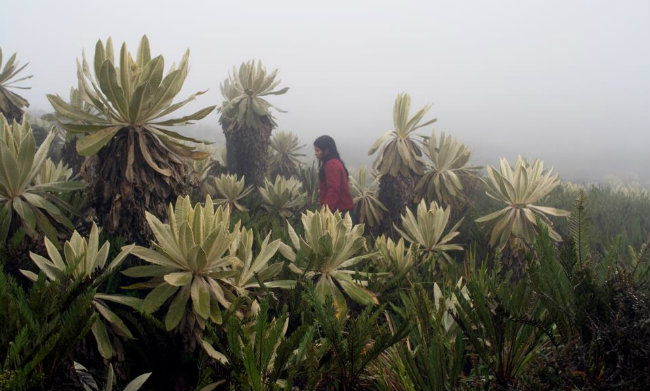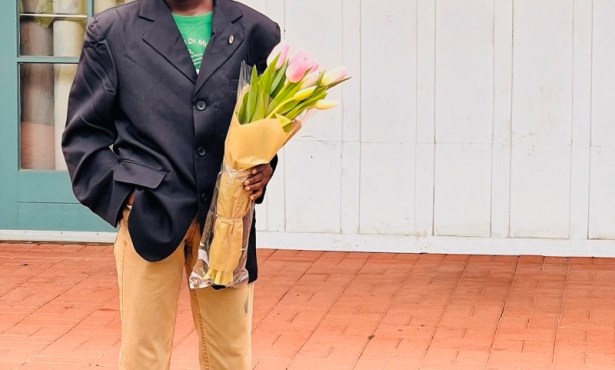La Sirga
Colombian Writer/Director William Vega Discusses His New Film

In writer/director William Vega’s stunning film La Sirga (The Towrope) we follow Alicia, a young Colombian refugee who flees to her uncle’s dilapidated guesthouse after her village is burned down. Set in a lakeside village in the Andes, the film’s slow pace and cryptic style feel both brooding and elegant, and help to tell a story about economy, social unrest, family, and human perseverance through thoughtful metaphors and symbolism. Below, we talk with Vega about his vision, as well as the story behind La Sirga‘s picturesque location. (Answers translated by Rebeca Conget.)
Can you tell me a bit about the inspiration behind the film? A few years ago I was directing a documentary series for TV. I was able to travel around to remote territories within Colombia; rural areas far from the urban centers where the socio-political problems that later translate into years long armed conflict are born and peasant communities that, without state protection and attacked by both right and left wing illegal armies, manage to survive in a land that is looted by outsiders on a daily basis. In one of these places I found a community that, after a very complex period of public order, was reconstructing its existence, rebuilding their life next to a beautiful lake. That place is La Cocha, a sacred area that encourages inspiration. It was full of symbols that dictated a story, a mix of real and imagined events, that came together in this fiction called La Sirga.
Is Alicia based on someone in particular? Alicia is not based on any one person in particular. It is more a symbol of the more than four million people displaced by the armed conflict in the Colombian countryside. She is a symbol of the fertile land that is desired by the great powers that want to appropriate it through violent means.
Was there a certain mood you were trying to capture with the film? Yes. There is a particular atmosphere in the natural conditions of the place, which we used as an expressive vehicle in the movie. The bleak humid climate, the cold and the fog all gradually create a very coherent mood for the story. The fog doesn’t let us see beyond certain limits, and this provokes an inevitable suspense. I think that is what the film is about; human incapacity to see it all. We all have a very partial vision and reading of what’s around us. That’s why the information in La Sirga, like in life itself, often remains behind the mist, out of the frame, or is limited to sounds.
Can you tell me a bit about the region you placed the film in? Is the economic situation really that bleak there? The film was conceived and shot entirely in this lake, La Cocha, in the Nariño department in South Western Colombia, near the border with Ecuador. This is a place that’s immensely rich in culture and ancient traditions, as well as being an environmental force. In the past, this richness and strategic location made it a main focus of the armed groups that confronted one another to fight for its territorial control. The film itself recreates that relevant moment in which the armed groups were starting their confrontations. Fortunately, the indigenous and peasant communities ideologically resisted this violence going through their land, and today they are an example of the joint concurrent work, which thanks to the retrieval of ancient knowledge and to a cosmogony where the number one priority is the relationship with the land and one another, they keep pushing forth a series of self-sustainable projects for their survival that do not harm the environment. In that sense the film shows the situation that was being felt there about 20 years ago. But more than pointing out a specific case of a place or a community, the film describes the situation that many have had to live through and that probably are still living through in other corners of the country and the world.
How important was it for you to leave things up to the viewer to interpret and why? As spectators I think we have been negatively influenced by a tendency to over-inform in movies. This has led us to models and formulas that are predictable by reiteration and obviousness. I took on the scriptwriting and direction of La Sirga thinking of the film I would like to see as an audience member. I don’t think the audience is a homogeneous mass, and since I don’t know all the people in the world, I did the story thinking of the only spectator I do know: Myself. In that sense I think the film leaves some gaps and some untied ends on purpose, as well as some element without a specific definition, just like in real life. A film is not a commercial where you are transmitting something very concrete to a potential audience. I believe each person interprets the movie and complements it in relation to their own existence and experiences. Perhaps tha’s the most interesting aspect of the project. In several Q&As around the world, when talking to the public, I have realized that I didn’t just make one movie but rather as many as the people who are seeing it.
The house plays an extremely important role in the film. It’s almost like a character. For you, what does the house represent? The house is a way to make visible what one cannot see in Alicia. Alicia is trying to pull herself together, rebuild herself and rise from the ashes. But we don’t see that in the character, who is quiet and inscrutable; rather we see it represented by the house. What’s interesting about the metaphor is that it raises certain conditions about the unfinished, the incomplete. So even if the lodge was completely repaired, it would still be missing the most important thing to truly be a hostel: The tourists. I think it’s a condition not just of the character but of humanity; we are never fully satisfied.
What films/filmmakers do you look up to or look to for inspiration? I see everything, I read everything, and I listen to everything. I believe that inspiration is everywhere, not only in film. I think the most important thing to be inspired is to travel, meet people, and have personal experiences, to then have something to tell the world.
Were there certain films/filmmakers that helped influence La Sirga? La Sirga itself does have some references to the work of Buñuel, Rosellini, and more recent auteurs such as the Dardenne brothers and the Turkish director Semih Kaplanoglu. I like to watch and get to know film and filmmakers from all over the world, because through them one also gets to travel and to understand this planet and its different societies.
What do you hope viewers take away from your movie? La Sirga not only tells a story, it makes you live it. It uses film language to get the audience to live an experience. It is not a representation, it is a presentation. I hope that when leaving the screening room the audience feels that they have lived a little more, and that they have learned more about life itself. If when it’s done they feel like they have lived more than 90 minutes, then we have succeeded.
What’s next for you? I am working on a new script. I have been selected to take part in the residence program of the Cinefondation of the Cannes Film Festival, where I will be writing this new project; a new story based on personal and made-up experiences that I hope we’ll be able to shoot in 2014.
La Sirga screens on Wed., Jan. 30 at 1:40 p.m. at Metro 4.



